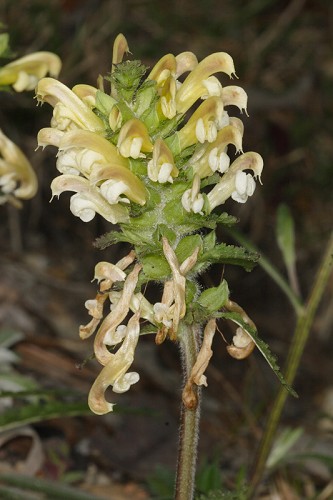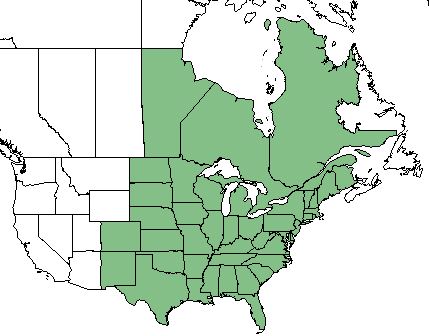Pedicularis canadensis
Common name: Canadian lousewort[1], eastern lousewort[2], wood-betony[2]
| Pedicularis canadensis | |
|---|---|

| |
| Photo by John Gwaltney hosted at Southeastern Flora.com | |
| Scientific classification | |
| Kingdom: | Plantae |
| Division: | Magnoliophyta - Flowering plants |
| Class: | Magnoliopsida - Dicots |
| Order: | Scrophulariales |
| Family: | Scrophulariaceae |
| Genus: | Pedicularis |
| Species: | P. canadensis |
| Binomial name | |
| Pedicularis canadensis L. | |

| |
| Natural range of Pedicularis canadensis from USDA NRCS Plants Database. | |
Contents
Taxonomic Notes
Synonyms: none.[3]
Varieties: none.[3]
Description
P. canadensis is a perennial forb/herb/subshrub of the Scrophulariaceae family native to North America and Canada.[1]
The stems are unbranched and up to 20 cm tall. The peduncle is pubescent and the rachis is tomentose. Leaves are deeply dissected, pinnately lobed, 5-15 cm long, 1.5-5 cm wide, and mostly clustered at the base of the stem. They have an alternate arrangement, elliptic shape, and serrate margin. Flowers are borne in dense heads, two-lipped, 2 cm long, and 0.5 cm wide. The corolla is yellow or shaded with lavender with capsules that are 12-16 mm long. The capsule is 1 cm long and enclosed by green sepals. Seeds are about 10 per capsule, 5 mm long, with a brown color.[4][3]
Distribution
This plant ranges from Maine, Quebec, and Manitoba, south to northeastern and Panhandle Florida, Texas, and northern Mexico.[3]
Ecology
Habitat
P. canadensis proliferates in moist to dry forests and woodlands and streambanks.[2] Specimens have been collected from loamy sand in hardwood forest, border of swamp area, and magnolia-beech-oak woods.[5]
Phenology
P. canadensis flowers from April through May and fruits from May through July.[3]
Fire ecology
P. canadensis is not fire resistant, but has a medium fire tolerance.[1]
Conservation, cultivation, and restoration
Cultural use
Photo Gallery
References and notes
- ↑ 1.0 1.1 1.2 USDA Plant Database https://plants.usda.gov/core/profile?symbol=PECA
- ↑ 2.0 2.1 2.2 Weakley, A. S. (2015). Flora of the Southern and Mid-Atlantic States. Chapel Hill, NC, University of North Carolina Herbarium.
- ↑ 3.0 3.1 3.2 3.3 3.4 Weakley, A.S. 2015. Flora of the southern and mid-atlantic states. Working Draft of 21 May 2015. University of North Carolina at Chapel Hill, Chapel Hill, North Carolina.
- ↑ Musselman, L. J. and W. F. Mann, Jr (1978). Root parasites of southern forests. , USDA Forest Service, Southern For. Exp. Station, New Orleans, LA. Gen. Tech. Rpt. SO-20. : 76.
- ↑ URL: http://herbarium.bio.fsu.edu. Last accessed: June 2018. Collectors: Loran C. Anderson, Rodie White, R.K. Godfrey, William Platt, M. Carr. States and counties: Florida (Gadsden, Jackson, Leon, Washington, Wakulla) Georgia (Thomas, Grady)